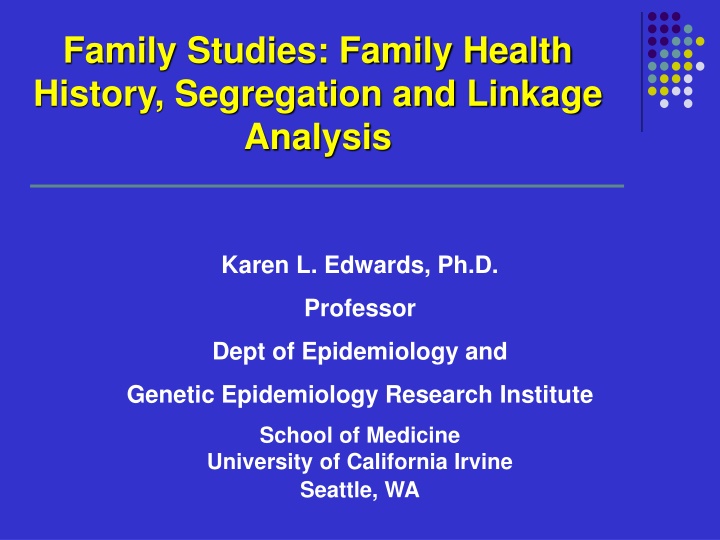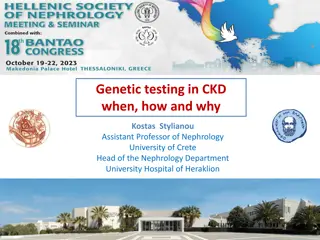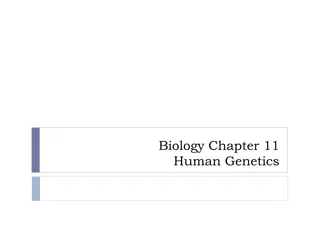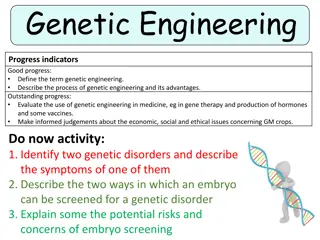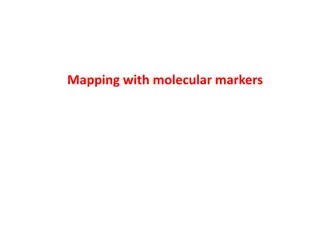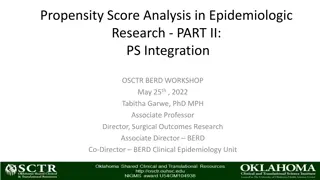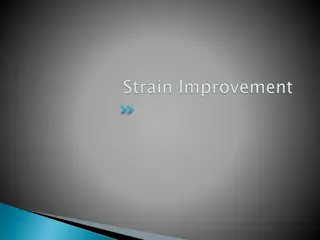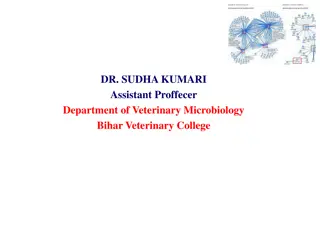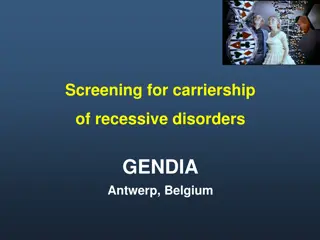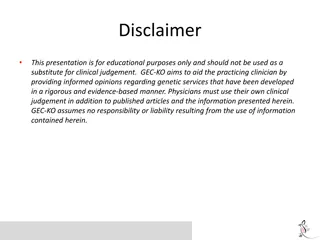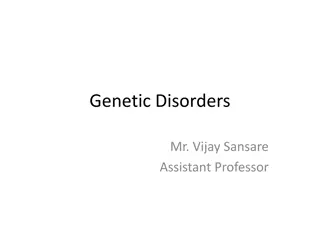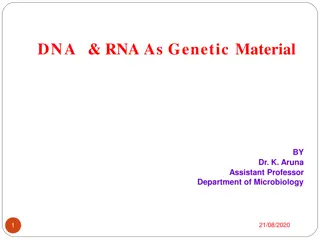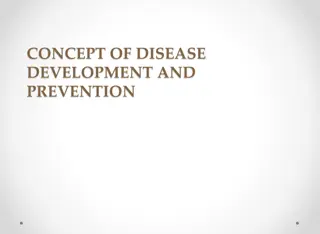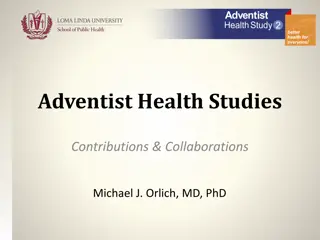Genetic Epidemiologic Studies and Family Health History
These studies delve into genetic influences on traits, familial aggregation, and major gene identification. Family health history aids in disease prediction and public health interventions, leveraging genetic, environmental, and behavioral factors. The goal is to use this information for behavior change and disease prevention.
Download Presentation

Please find below an Image/Link to download the presentation.
The content on the website is provided AS IS for your information and personal use only. It may not be sold, licensed, or shared on other websites without obtaining consent from the author.If you encounter any issues during the download, it is possible that the publisher has removed the file from their server.
You are allowed to download the files provided on this website for personal or commercial use, subject to the condition that they are used lawfully. All files are the property of their respective owners.
The content on the website is provided AS IS for your information and personal use only. It may not be sold, licensed, or shared on other websites without obtaining consent from the author.
E N D
Presentation Transcript
Family Studies: Family Health History, Segregation and Linkage Analysis Karen L. Edwards, Ph.D. Professor Dept of Epidemiology and Genetic Epidemiology Research Institute School of Medicine University of California Irvine Seattle, WA
Overview of Genetic Epidemiologic Study Design Question Approach Is there evidence for genetic influences on a quantitative trait? Commingling Is there familial aggregation? higher risk in relatives or higher correlation in relatives Family Study Is the familial aggregation caused by genetic factors? MZ twins concordance rate or correlation higher than DZ twins Twin Study Is there a major gene? Is it dominant or recessive ? (likelihood of Mendelian models higher than environmental or polygenic model) Segregation Analysis Where is this major gene in the human genome? Linkage Analysis Is there a linkage with DNA markers under a specific genetic model? A. Parametric Approach Is there an increased allele sharing for affected relatives (sib pairs) or for relatives with similar phenotype B. Allele Sharing Approach (sib-pair analyses) Association Study (population and family-based) Where is the disease causing gene and which polymorphism is associated with disease?
Family Health History: Application to public health Advantages: Reflects multiple genetic, environmental, behavioral factors and interactions No genetic test can do this Family history is a predictor of most diseases (diabetes, cancers, CVD) Effective (public health) interventions exist for many of these diseases Quitting smoking, maintaining ideal body weight, diet, exercise Overcomes one of the most important barriers - getting people interested in learning and talking about their health Goal: Use family history information to motivate behavior change and promote a healthy lifestyle for primary prevention of disease More personalized health messages that fit within pre-existing beliefs about current health status, possible causes and risk factors, course of the disease, magnitude of and potential consequences of the risk, and ways to reduce the risk See Claassen et al. BMC Public Health 2010, 10:248
Genetic Epidemiology Segregation Analysis
Complex Segregation Analysis (CSA) A modeling approach used to determine whether there is evidence for a single gene that underlies a trait or disease Also provides information on mode of inheritance Dominant, Recessive or Codominant General method for evaluating the transmission of a trait within pedigrees Mendelian transmission
CSA, cont Information from CSA is useful in model based (parametric) linkage methods LOD method linkage analysis depends on the specification of a reasonable model, including an approximation of the mode of inheritance Assumes the existence of a Mendelian trait
The goal To test for compatibility with Mendelian expectations by estimating parameters for a range of genetic models CSA can provide the statistical evidence for Mendelian control of a trait or disease As with all methods so far, this evidence can be used to support a genetic cause of the disease, but is not definitive Simultaneously considers major locus, polygenic and environmental effects
The Approach A variety of models are fit to the family data and compared using a likelihood ratio test (for nested models) The null hypothesis is that the data DO fit with some model of inheritance (genetic or not)- a "goodness of fit" approach
The Models The models are formed by estimating and restricting a specified set of parameters The most general model, where all parameters are estimated Single locus models with no polygenic inheritance and differing modes of inheritance Polygenic model, with no single locus effect Mixed model, both single gene and polygenic components Nongenetic model or "environmental model"
Parameters: single locus component Means (u) for each subdistribution Variance of each subdistribution Allele frequencies Transmission probabilities - should conform to Mendelian expectations t1 = P(AA parents transmits A allele to offspring) = 1.0 t2= P(Aa parents transmits A allele to offspring) = 0.5 t3 = P(aa parents transmits A allele to offspring) = 0.0
Parameters : Polygenic component Heritability (h2) proportion of variance due to additive genetic effects Not a single major gene Can reflect residual genetic effects not accounted for by a single major locus Sometimes referred to as multifactorial component
Model Testing Hypothesis testing for nested models using the LRT (likelihood ratio test) LRT = -2 [In L(reduced model) - In L(full model)] LRT is distributed as a chi square with the degrees of freedom (df) equal to the difference in the number of estimated parameters The likelihood of each model is proportional to the probability of the data, given the model and family structure
Model testing, cont To compare non-nested models use the AIC to compare (not test) models to support a particular model over another AIC= -2(ln likelihood) + 2(number of estimated parameters) Calculate the AIC for each competing model and select the one with the smallest AIC as being the most parsimonious
Interpretation: Inferring A Major Gene To infer a major gene reject nongenetic models accept a major gene model (single or mixed model) should always test transmission probabilities in CSA of quantitative traits to safeguard against false inference of a major gene
Ascertainment Correction Ideal probands would be newly diagnosed, population based (incident) cases Should correct for ascertainment unless pedigrees (probands) are selected from a random, population based sample Correction for ascertainment is not straightforward and is not usually done Estimators for population parameters (allele frequency and heritabilty) will be most affected
Am. J. Hum. Genet. 43:311-321, 1988 Sources of Interindividual Variation in the Quantitative Levels of Apolipoprotein B in Pedigrees Ascertained through a Lipid Clinic Gail Pairitz,* Jean Davignont Helene Maillouxt and Charles F. Singt *Department of Medicine, Hospital of the University of Pennsylvania, Philadelphia; tDepartment of Lipid Metabolism and Atherosclerosis Research, Clinical Research Institute of Montreal, Quebec; and tDepartment of Human Genetics, University of Michigan, Ann Arbor Summary The quantitative level of apolipoprotein (apo) B associated with low-density lipoprotein (LDL) varies among individuals within the population. This variation in level of the LDL receptor ligand appears to have predictive value, and may have an etiologic role, in coronary artery disease. Complex segregation analysis was used to compare eight different models of transmission. This study confirms the existence of allelic variations at a single genetic locus with large effects on the interindividual variation in the level of the serum apo B associated with LDL. This is the first study to consider the possible effects of inherited polymorphic variation in the apo E molecule when analyzing the components of variation in apo B associated with LDL. Our analyses suggest that the common alleles coding for the apo E polymorphism act independently of the unmeasured single-gene locus characterized by this study.
Other Issues to Consider Nonpaternity seems to have little effect on the ability to select models Can adjust for covariate effects Can also consider adjusting for other known genetic factors affecting your trait of interest
Important Limitations in CSA Implicit assumption of etiologic homogeneity Power is difficult to estimate as there is no single nongenetic alternative model, but instead a range of competing models Sample size Larger extended kindreds with several generations are generally better than small nuclear families generally requires a large amount of data, with more complex models requiring more data
Summary of CSA Does not require genotype data Can be time consuming to complete analyses Information from CSA is useful for a variety of reasons Preliminary data, estimates for linkage analyses, choice of phenotype Assumes the existence of a Mendelian trait
Standardized Human Pedigree Nomenclature: Update and Assessment of the Recommendations of the National Society of Genetic Counselors. Authors: Bennett, French, Resta, Lochner Doyle Standard format and nomenclature for drawing pedigrees Pedigrees convey lots of information Picture is worth a 1000 words Sensitive information and how to display? J Genet Counsel (2008) 17:424 433
Bennett article - some key points A medical pedigree is a graphic presentation of a family s health history and genetic relationships A pivotal tool in the practice of medical genetics / genetic epi research Interpreting a pedigree should be a standard competency of all health professionals Pedigrees should not contain information about which a subject had no prior knowledge. a person who had presymptomatic or susceptibility genetic testing through research should not find out about increased or decreased disease risk status from a publication
In Class Exercise: Pedigree Drawing Let me start with my great-great grandparents: Jim and Ann Flight. They had two children: Kathy, and Gerry. Kathy died in a car accident along with her father Jim. Gerry married Kate Doe. Kate and Gerry had one child, Kathy Kathy Flight married David Dewey and they had my dad, Bob. My dad took his mother s maiden name because David had an affair with someone named Maggie Braun. After Jim s death, Ann married Paul Wright. Ann and Paul had one child: Tom Wright. Tom Wright married Kaisa Stone. Tom and Kaisa had one daughter: Heather. Heather Wright was wed to Peter Meter and had one child, Jean. Jean married Bob Flight and they had me Jane Flight.
In Class Exercise: Collecting Family History Information Think about your own family history - Do you know the vital status of your immediate family members, what about more distant relatives? - Do you know the DOB and DOD for your immediate family members, what about more distant relatives? - What health conditions run in your family? - Do you know age or date of onset? - How confident are you in this information? Draw your pedigree, indicating as much of the following as possible - vital status, health conditions, age at onset or death
Genetic Epidemiology Linkage Analysis
Linkage Analysis, overview Linkage Location of genetic loci sufficiently close together on a chromosome that they do not segregate independently linkage is a property of loci (not alleles), and evaluation involves all alleles at the marker locus the specific alleles segregating in one family may differ from alleles at the same locus segregating in a different family
Linkage vs. Association Linkage Cosegregation of a disease or trait with a specific chromosomal region in multiple families Genetic linkage is the tendency of two loci to be inherited together (e.g. loci are on the same chromosome) Property of two loci (genes or locations) Association Presence of a disease or trait with a specific allele in a gene or marker (in unrelated subjects) probably due to linkage disequilibrium
Linkage Analysis background The aim of linkage analysis is to infer the relative position of two or more loci Examining patterns of allele sharing or cosegregation of marker and disease in relatives The location of one locus is known (the marker), the other is unknown (the disease causing gene) Alleles of loci on the same chromosome can violate Mendels s law of independent assortment (linkage) Evidence of linkage between a known marker and a putative gene for a disorder is the ultimate statistical evidence for a genetic component in disease etiology
General Approaches to Linkage Analysis Genome Wide Scan Isolate a gene solely on the basis of it's chromosomal location, without regard to it's biochemical function. This is often referred to as the "positional genetic" approach (i.e. genome screens are often referred to positional cloning) Candidate gene approach Select candidate genes based on their function or other known properties
Required data for family studies At least pairs of related individuals Accurate pedigree structure / biological relationships Nuclear family vs. extended kindred Phenotype data quantitative or categorical Genotype data Location of markers (marker map)
Genetic Markers A genotype (measurable "trait" ) that is genetically determined, can be accurately classified, has a simple, unequivocal pattern of inheritance (and polymorphic). Types of genetic markers Polymorphic markers lots of alleles / variation Variable number of tandem repeats (VNTR) Microsatellites, (e.g. CA repeats), very polymorphic Single nucleotide polymorphisms (SNP's) - 2 allele markers, very common Sequence data exome or whole genome
Statistical Analysis: LOD based Linkage Analysis Involves comparison of likelihoods of observing the segregation pattern of 2 loci under specific models, including Under the null hypothesis of no linkage Independent assortment loci recombine as if on different chromosomes Alternative hypotheses of linkage differ in the extent of crossing over (i.e. different values of recombination events)
LOD Score LOD score = log (base 10) of the odds of linkage vs. no linkage (not an odds ratio!) LOD score > 3, supports linkage, corresponds to a genome-wide type 1 error rate of 0.05 (depends on number of markers tested) LOD score < -2, used to exclude a chromosomal region Exclusion mapping add LOD scores from all families to obtain LOD score for your sample Assumes families are independent
Linkage Mapping of CVD Risk Traits in the Isolated Norfolk Island Population Abstract: To understand the underlying genetic architecture of cardiovascular disease (CVD) risk traits, we undertook a genome-wide linkage scan to identify CVD quantitative trait loci (QTLs) in 377 individuals from the Norfolk Island population. The central aim of this research focused on the utilization of a genetically and geographically isolated population of individuals from Norfolk Island for the purposes of variance component linkage analysis to identify QTLs involved in CVD risk traits. -The ancestral origins of the Norfolk Island are well documented and originated from divergent founding paternal and maternal lineages, European and Tahitian, respectively. -1,574 residents -Exhaustive genealogical documents indicate that the population grew from a limited number of initial founders (nine males, twelve females) and in relative isolation in the early generations of population expansion - Evidence of the Island's strict immigration laws are obvious by the limited numbers of surnames, resulting in the worlds only telephone directory which includes nicknames to differentiate between individuals with the same name Hum Genet. 2008 December ; 124(5): 543 552. doi:10.1007/s00439-008-0580-y.
Linkage Mapping of CVD Risk Traits in the Isolated Norfolk Island Population The Norfolk Island genealogy dates back approximately ten generations to the initial founders and contains 6379 individual entries linked together within 2185 nuclear families. The complexity of the island's heritage is evident considering 5750 individuals reside within a single multifamily pedigree exhibiting 1661 marriages and 1233 founders. Methods: Substantial evidence supports the involvement of traits such as systolic and diastolic blood pressures (SBP and DBP), high-density lipoprotein-cholesterol (HDL-C), low-density lipoprotein cholesterol (LDL-C), body mass index (BMI) and triglycerides (TG) as important risk factors for CVD pathogenesis. In addition to the environmental influences of poor diet, reduced physical activity, increasing age, cigarette smoking and alcohol consumption, many studies have illustrated a strong involvement of genetic components in the CVD phenotype through family and twin studies. We undertook a genome scan using 400 markers spaced approximately 10cM in 600 individuals from Norfolk Island. Genotype data was analyzed using the variance components methods of SOLAR. Results: Our results gave a peak LOD score of 2.01 localizing to chromosome 1p36 for systolic blood pressure and replicated previously implicated loci for other CVD relevant QTLs. Hum Genet. 2008 December ; 124(5): 543 552. doi:10.1007/s00439-008-0580-y.
Sib-Pair Linkage Analysis Sib pairs are generally easier to collect, tend to be more closely matched for age and environment than other relative pairs Qualitative trait: under linkage, Affected relative pairs should share alleles IBD (inherited from a common ancestor within the pedigree), more often than expected under Mendelian expectations Quantitative trait: relative pairs should show a correlation between the magnitude of their phenotypic difference and the number of alleles shared IBD
Quantitative sib-pair linkage A regression approach Regress the squared within-pair difference of a quantitative trait on the number of marker alleles shared IBD Null hypothesis - the slope of the squared within pair difference is zero The alternative hypothesis is that under linkage, the slope is negative.
Identity by descent vs. Identity by state IBS- two alleles at a given locus are identical in state if they represent the same allelic variant at that locus IBD- two alleles at a given locus are IBD if they were transmitted from a common ancestor ie they represent copies of the same ancestral DNA
Quantitative Sib-pair linkage results 100 BMI: Slope of the line is negative Squared trait difference 50 10 0 1 2 Alleles shared IBD at a specific locus
